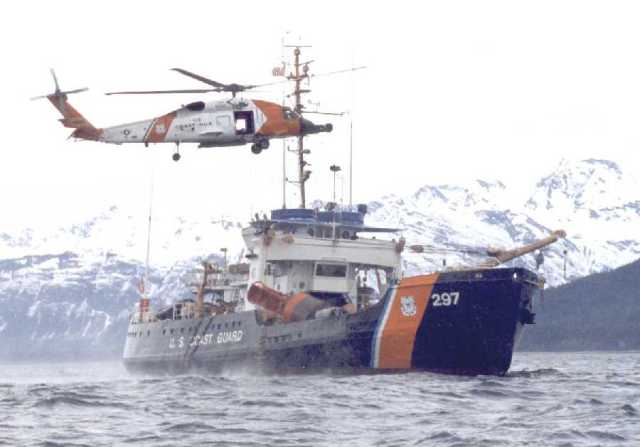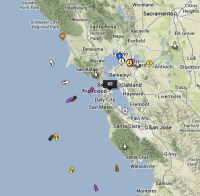Today is the birthday of America’s oldest armed maritime service, known today as the United States Coast Guard.
It began on August 4, 1790 when President Washington signed the Tariff Act that authorized construction of ten vessels, referred to as “cutters,” to enforce federal tariff and trade laws and to prevent smuggling.
On March 31, 1941 Marine Iron and Shipbuilding in Duluth, Minnesota, laid the keel for the first Coast Guard vessel of a new buoy tender class.
The new vessel measured 180 feet overall and had a beam of 37 feet at the extreme. She had a displacement of 935 tons and drew 12 feet.
Marine Iron and Shipbuilding built all but one, the Ironwood, built at the USCG yard in Curtis Bay, Maryland, launched and commissioned in 1943.
After shakedown Ironwood departed Norfolk for War in the Pacific, arriving in Noumea, New Caledonia via Bora Bora and Pago Pago, in March 1944.
During World War II, the Ironwood and her sister ships covered thousands of miles of open ocean, working to establish Long-Range Aids-to-Navigation (LORAN) stations, moving and establishing mooring buoys, and carrying cargo, mail and personnel between South Pacific islands.
Some accounts portray a more glamorous role for Ironwood. But a clear, no-nonsense look at her service seems more appropriate and respectful. Ironwood was never a frontline war-ship, but she was always work horse, a blue-collar vessel that responded to every necessity.
Ironwood was there in March 1944 to take aboard stranded sailor and Marines from the grounded merchant vessel SS John Lind. She next carried a cargo of seed potatoes for Suva in the Fiji Islands, then another cargo for Vunda Point. While in Fiji she also removed mooring buoys and moorings before setting course for Pago Pago transporting Navy personnel to the American base in Samoa.
While in Samoa, Ironwood continued the hard work she was designed for, removing anti-torpedo net buoys and mooring buoys, then departing for the Ellice Islands and Funafuti to continue that work before returning to Noumea where she continued yet again.
In late August, Ironwood set course for New Hebrides where she engaged in removal of underwater harbor defenses and fleet moorings in Havannah and Fila Harbors including salvage of 800 tons of mooring chain.
By the end of August, 1944, Ironwood was underway with a pontoon barge under tow, bound for Fila Harbor. She returned to Noumea just long enough for necessary repairs and maintenance before departing again for the New Hebrides to replace channel buoys and obstruction buoys in Havannah Channel.
By late September, Ironwood was again underway with a Navy pile driver in tow bound for Nepui, later returning to Noumea. Two months later Ironwood is again underway for Suva for removal of harbor defense installations before departing for Vunda Point with a Navy pontoon bridge in tow.
At Vunda Point, Ironwood continued with removal of mooring buoys in Nandi anchorage and reestablished those at Vatia Harbor.
By December, 1944, Ironwood had moved on to Lautoka on the north side of Fiji, where she removed underwater sonar cable and salvaged anchors and chain before returning to Noumea with cargo, mail and Navy personnel aboard.
En route to New Caledonia, she changed course to investigate a radio distress signal but was unable to locate the vessel and continued on toward Noumea to disembark passengers and transfer salvaged anchors and chain to a Navy barge.
On Christmas day 1944 Ironwood departed Noumea for Gavutu Island in the central Solomons, there removing and resetting mooring buoys in nearby Purvis Bay and Tulagi Harbor entrance.
In January, 1945, Ironwood departed Gavutu Island to salvage a Japanese two-man Japanese submarine that had been discovered off Cape Esperance . After divers cleared space bow and stern for chain slings, the submarine was raised, secured alongside Ironwood and transported to Florida Island where it was transferred to a Navy crane barge.
Almost immediately, Ironwood proceeded to Guadalcanal to removal small craft moorings then on to Banika Island to take aboard a cargo for Gavutu.
During February, Ironwood anchored off Guadalcanal for painting, repairs and alterations before departing again for Banika Island with 2000 bags of mail aboard
Returning to Gavutu, Ironwood set to work removing mooring buoys from Purvis Bay, then proceeded South to Espiritu Santo for removal of fleet moorings from Segond Channel.
Ironwood departed Gavutu in June with two Navy barges in tandem-tow bound for Guam with a brief stopover at Eniwetok, arriving in Guam on August 2, 1945. From Guam Ironwood set course for Leyte in the Philippines arriving on August 6th, the day that a B-29 named Enola Gay dropped an atomic bomb on Hiroshima and changed the world forever.
In the world-shaking weeks that followed, as Japan finally capitulated and then formally surrendered aboard the USS Missouri on September 2, 1945 in Tokyo Bay, the Ironwood continued her work, tending to aids to navigation in the Philippine Islands until the summer of 1947 when she was reassigned to Monterey, California to continue the necessary tasks of her class.
As war erupted again, in Korea in 1950, Ironwood returned to Guam, servicing LORAN stations throughout the Pacific until reassignment to Honolulu, where that work continued.
She was later reassigned to Homer, Alaska, where ANTON duties were occasionally broken by search and rescue and calls of distress by ships at sea. There, in the Spring of 1989, Ironwood assisted with the cleanup operations in Prince William Sound after the grounding of the Exxon Valdez.
Ironwood was decommissioned on October 6, 2000 and was eventually transferred to the Department of the Interior, her service continuing today as a training vessel for the JobsCorps Maritime Training Program at Tongue Point, Astoria, Oregon
There, under the able direction of Capt. Len Tumbarello, USCG (Ret.), Tongue Point operates the only seamanship program among Job Corps’ 125 centers nationwide, insuring that the former Coast Guard cutter Ironwood will continue to quietly impact the lives of all who board her.


